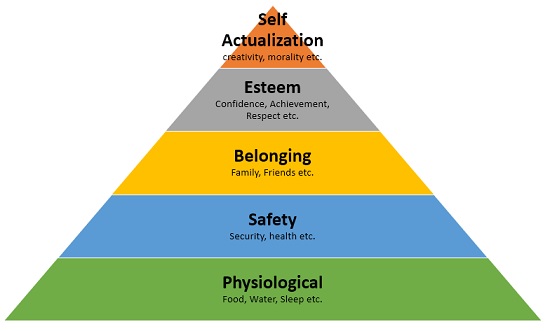- Business Concepts ›
- Marketing and Strategy ›
- Needs
Needs
Definition, Importance, Types & Example
This article covers meaning & overview of Needs from marketing perspective.
What is meant by Needs?
Needs are basic or advanced urges or demands that lead us to take an appropriate action to fulfill them. In terms of marketing, needs are the gaps which the companies try to fulfill with their products and services. The entire field of business and management is built around fulfilling the needs and demands of the customer hence making needs one of the most important aspect.
Importance of Needs in Marketing
The needs of human beings are best described by Maslow’s Hierarchy of Needs given below: -

The buying behaviour of the consumer depends on his position in the hierarchy. The behaviour changes as he moves up in the hierarchy.
Example: -
If a consumer is able to fulfil his basic needs i.e. Physiological Needs he will then move one step up and look for safety needs.
For a business, knowing the needs and the stage in the hierarchy is very important. The entire strategy and innovation of the product along with differentiation would be to meet this need.
The companies have to offer more than the basic needs. They have to understand all the needs along with the 'wants' of the customer. If the product or service offering cannot meet the needs of the customer, then the customer would not buy it more than once (or even once) but on the other hand if the product meets the expected needs then the customer might not only buy it but also become a regular customer and inform other customers about the product.
Difference between Needs and Wants
Needs and wants are both what the companies and brand want to fulfill but they both are not the same. Need is at the basic level of requirement which a person or customer would need to fulfill to do what is required but wants are something which are what is not mandatory but still a person requires for personal aspiration, preference or esteem. A simple example can be car for need to travel. Now any car which can take a person from point A to point B can fulfil the need but a customer may 'want' a SUV with 4 wheel drive to fulfil the same 'need'.
5 Types of Needs in Marketing
Need, in terms of marketing can be divided into the following five types:
1. Stated
Stated Needs are the ones which are specified clearly by the customer or the market. They are also the expected needs for a particular product or service. These needs are at the most basic level without which the need cannot be qualified. e.g. I need food to eat and i feel like having a sandwich.
2. Real
Real needs are at one level above the stated needs and put a boundary on the above. Real needs define the parameter which are immediate to defining and fulfilling the need. e.g. I need a cheese sandwich at affordable price.
3. Unstated
Unstated needs are which are not obvious but are expected by the customer. These are the needs which can be used to differentiate by the companies while designing the products to fulfil the needs of the customer. e.g. I need basic vegetables to be added as part of my sandwich. It should not be just a single slice cheese plain sandwich.
4. Delight
Delight needs are the needs which provide the 'wow' factor. These needs like unstated needs can make some products more popular than the other if they meet these needs. e.g. The quality of the cheese used to be the best one with special sauce but still the price of the sandwich would be below 2$.
5. Secret
These are the needs which a customer might not state or realize but can be one of the main reasons for choosing a particular product to fulfil the basic stated need. e.g. i need this sandwich to quickly eat my food and look cool.
Example of Needs
For example a customer wants to buy a car. When consumer says he wants something, like an expensive car, that is his stated need. When the consumer wants a car for rational, genuine need, like he wants a car whose operating costs are low over a time, and not just a low initial price, this is his real need. In buying this car, the consumer also expects a good service from the dealer. This is the unstated need. When the consumer doesn’t explicitly express that he would want something but would like to have it anyway, say for example he would like the car dealer to include an onboard GPS navigation system too; this becomes a delight for him. Lastly, there is a desire seldom shown, this may be a secondary benefit of obtaining the product, yet equally important or might as well be the main reason, but not expressed so readily. For example, here the consumer wants a car for the status symbol so that he can show his friends that he is a savvy consumer. This is when he has a secret need to appear to fit in.
Hence, this concludes the definition of Needs along with its overview.
This article has been researched & authored by the Business Concepts Team which comprises of MBA students, management professionals, and industry experts. It has been reviewed & published by the MBA Skool Team. The content on MBA Skool has been created for educational & academic purpose only.
Browse the definition and meaning of more similar terms. The Management Dictionary covers over 1800 business concepts from 5 categories.
Continue Reading:
What is MBA Skool?About Us
MBA Skool is a Knowledge Resource for Management Students, Aspirants & Professionals.
Business Courses
Quizzes & Skills
Quizzes test your expertise in business and Skill tests evaluate your management traits
Related Content
All Business Sections
Write for Us